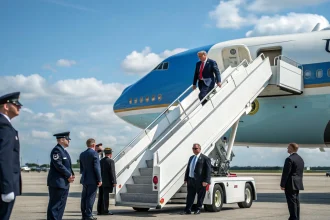Walmart named a successor to Chief Executive Doug McMillon, setting Feb. 1, 2026, as the handover date and tapping John Furner, the current head of Walmart’s U.S. operations, to take the helm. The move signals a long runway for one of the world’s largest retailers to prepare for a change at the top, while keeping leadership in familiar hands.
The company said the plan is set more than a year in advance to allow for a steady transition. It also keeps its next leader close to the core U.S. business that drives most of its sales and profit.
“Walmart said Doug McMillon will be replaced on Feb. 1, 2026, by John Furner, head of Walmart’s U.S. operations.”
Why The Timeline Matters
Announcing the change now gives investors, employees, and suppliers time to adjust. Such lead time is common at global companies that want to avoid disruption. It also suggests McMillon will remain active in planning and strategy through 2025, helping align priorities with his successor.
Walmart’s size makes continuity a priority. The company runs thousands of stores and a major e-commerce operation. A long transition helps preserve momentum in logistics, technology investments, and merchandising plans tied to long annual cycles.
Who Is John Furner
Furner leads Walmart U.S., the company’s largest division by sales. That role covers stores, e-commerce in the U.S., supply chain, and day-to-day operations in its home market. Elevating the head of U.S. operations follows a pattern seen in big-box retail, where operational depth and store execution are central.
His appointment points to a strategy focused on strengthening the core U.S. business, expanding online grocery, and improving delivery and pickup services. It also hints at continued attention to price leadership and inventory discipline, where the U.S. unit sets the pace.
McMillon’s Tenure And The Road Ahead
McMillon has steered Walmart through rapid changes in shopping habits, a crowded e-commerce market, and supply chain shocks. Under his watch, the company pushed harder into online sales and last-mile delivery while upgrading stores to serve both in-person and digital demand.
Challenges remain. Walmart faces tight consumer budgets, rising labor and transport costs, and an arms race in retail technology. A planned, internal succession offers stability as the company navigates those pressures.
- Hand-off date: Feb. 1, 2026
- Incoming leader: John Furner, Walmart U.S. head
- Outgoing leader: Doug McMillon
What It Means For the Industry
Retail peers have also leaned on leaders with strong operations backgrounds. The everyday job of keeping shelves stocked and prices sharp has become more complex with data-driven inventory systems and blended online-store networks. Walmart’s choice suggests the company will keep betting on execution at scale, supported by tech but anchored by store performance.
Suppliers may see few near-term changes. A predictable transition reduces the risk of sudden shifts in vendor terms or product mixes. For competitors, the message is simple: stability at Walmart means intense pricing pressure and continued gains in grocery and essentials, where the retailer has been adding share.
Signals To Watch
As the date approaches, watch for leadership moves under Furner in e-commerce, merchandising, and supply chain. New appointments often preview strategic priorities. Also watch capital spending guidance, which could indicate how Walmart balances store upgrades with automation and fulfillment investments.
Employee initiatives will be another signal. Training, scheduling tools, and wage investments have shaped store performance in recent years. Those choices will influence customer service and in-stock rates, key drivers for foot traffic and online repeat orders.
The transition also lands as major retailers test new revenue streams, such as advertising on retail media networks and healthcare services. Whether Walmart accelerates or trims those bets under Furner will show where management sees the best returns.
With the date now set, Walmart has time to manage a careful hand-off. The plan points to continuity, not a pivot. For shoppers, that likely means low prices and faster delivery remain at the center. For rivals, it means the nation’s largest retailer is lining up its next play without taking its eye off the ball.








